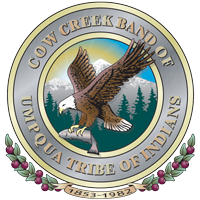At Winchester Dam, Every Pacific Lamprey Counts
*This article appears in the September 2022 issue of the Tribal newsletter. Tribal members may log in to read the current issue or past issues of the newsletter by clicking here.*
Biologists with the Cow Creek Umpqua Natural Resources team and Tribal students are getting an up-close look at Pacific lamprey in the North Umpqua River.
With the Oregon Department of Fish and Wildlife, Tribal intern Samantha Morris and Fisheries Biologist Travis Mackie recently helped count Pacific lamprey at Winchester Dam in Roseburg.
The unique experience is one that isn’t available just anywhere.
“Winchester is the last place where we have dam counts of lamprey in Southern Oregon,” says Kelly Coates, Cow Creek Natural Resources Director, and Tribal Co-Chair of the Pacific Lamprey Conservation Initiative. “The next closest is the dams on the Columbia.”
Counts are recorded by how many Pacific lamprey make it up and over the dam, with help from a specially designed ramp. Traditional fish ladders aren’t built for lamprey because of fast-moving water and right angles.
“They don’t swim like a salmon does. They have a sucker-like mouth that attaches to a wall,” says Mackie. “So when they get to a 90-degree corner, they can’t get around the corner, so they lose suction and wash down.”
Lamprey use their tail for a burst of energy to move forward and up the ramp at Winchester. At the top of the ramp, they fall into a box, and are counted by hand.
Morris was the lucky person to reach into the box and count.
“When you open the box, there’s just lamprey everywhere, and they’re all stuck to the sides,” she says. “It was hard to grab them. They are fast and really jerky when they move, so I had to hold its head and its tail was whipping around. They’re just pure muscle.”
Pacific lamprey populations at Winchester Dam are a fraction of what they were decades ago. According to ODFW historical records, as many as 46,000 Pacific lamprey were counted at the dam in 1966. In 2021, ODFW recorded 1,148 Pacific lamprey at Winchester.
“The populations are dwindling pretty fast,” says Mackie. “The lamprey ramp is a way for us to better monitor the populations which help us understand what the numbers are.”
Low populations are due to a multitude of environmental factors that are “actually a massive population decline range wide,” according to Coates, which goes from Baja up through Alaska and over to Kamchatka, Russia and Japan.
Morris wants to continue studying Pacific lamprey and their important ecological and cultural role.
“Lamprey are good for the rivers, and they are the coolest little creatures that nobody knows about,” she says. “They were very important to the Tribe.”
Pacific lamprey are a first food of the Cow Creek people. They were caught in nets and baskets, often at South Umpqua Falls, and then dried and smoked.
“They’re really fatty and oily, so they provided a lot of nutrients,” says Cow Creek Cultural Resources Manager Jennifer Bryant.
Cow Creek Natural Resources plans to continue to observe ODFW’s counts of lamprey at Winchester.
“Everything that we do, the counts that happen at Winchester, feed into knowledge that’s shared at a regional level,” says Coates.






